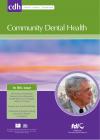Community Dental Health

- Cover Date:
- December 2009
- Print ISSN:
- 0265 539X
- Vol:
- 26
- Issue:
- 4
Fluoride toothpaste utilization behaviour among preschool children in Perlis, Malaysia
Background Very mild fluorosis is quite prevalent in children and one of the sources may be attributed to poor fluoride toothpaste utilization habits. Aim To investigate the frequency of toothbrushing, parental supervision, the person who usually applied the toothpaste, toothpaste swallowing and spitting habits, size of toothbrush, type of toothpaste used and amount of toothpaste used by shape and weight. Methodology Observational cross-sectional study of a representative random sample of 373 children aged 5-6 year-old. The children were interviewed using a structured close ended questionnaire. Direct observations were made on their toothpaste dispensing habit during a toothbrushing exercise. Results All children reported practising toothbrushing with 90% on a daily basis. Almost all used fluoridated toothpaste (91.4%). About one-half (50.7%) reported that their parents never supervised them. More than one-third of children used adult toothpaste and 60.1% of the toothpaste was flavoured. Most (92%) used toothbrush meant for children. About 40% applied a pea-sized amount of toothpaste. The mean weight of toothpaste applied was 0.43g (SD+0.35g). Conclusions The majority used the recommended child-sized toothbrush and toothpaste that contained fluoride but less than one-half of the parents supervised their children. Most children used flavoured children’s toothpaste but a sizable proportion used toothpastes meant for adults. The amount applied by shape and weight exceeded the amount recommended by experts.
Key words: Fluoride, fluorosis, preschool children, toothpaste.
- Article Price
- £15.00
- Institution Article Price
- £
- Page Start
- 211
- Page End
- 215
- Authors
- H.L. Tay, I.S. Zainudin, N Jaafar
Articles from this issue
- Title
- Pg. Start
- Pg. End
- Evaluation of the direct and diffusion methods for the determination of fluoride content in table salt
- 204
- 210
- Rural Mexican immigrant parents’ interpretation of children’s dental symptoms and decisions to seek treatment
- 216
- 221
- Assessment of HIV/AIDS awareness among 500 patients referred to the Ankara University Faculty of Dentistry
- 222
- 226
- Professional charges not reimbursed to dentists in the US: evidence from Medical Expenditure Panel Survey, 1996.
- 227
- 233
- Quality of life in patients with dental conditions: comparing patients’ and providers’ evaluation
- 234
- 238
